The old wetting agent trick...
Frank Tichenor, Forest Hill Field Club, Bloomfield, NJ:
 "I don't know how long this trick has been around but I first started using it last year. When we have an area that gets very dry due to lack of irrigation, poor soils, or lack of rainfall the area becomes hydrophobic. Hydrophobic means that water has a tough time penetrating these areas and they become very hard to rewet. When this becomes an issue I use a trick that I read on TurfNet, a website community that I belong to. The photos below show the process. Wetting agents help alleviate the problems associated with hydrophobic conditions. Maybe the best way to explain it is they make "wetter water". "I don't know how long this trick has been around but I first started using it last year. When we have an area that gets very dry due to lack of irrigation, poor soils, or lack of rainfall the area becomes hydrophobic. Hydrophobic means that water has a tough time penetrating these areas and they become very hard to rewet. When this becomes an issue I use a trick that I read on TurfNet, a website community that I belong to. The photos below show the process. Wetting agents help alleviate the problems associated with hydrophobic conditions. Maybe the best way to explain it is they make "wetter water".
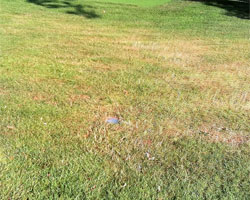
An area that has gotten dry and hydrophobic. |
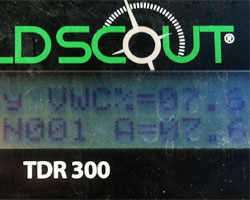
Our moisture meter indicates the volumetric water content is only 7.6%.
|
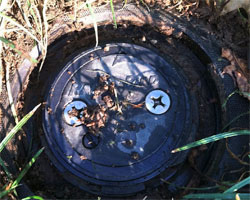
We begin by removing the rotor on the sprinkler head for this area. |
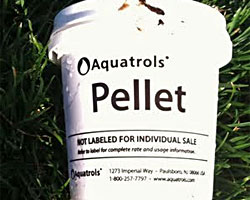
Next we use a wetting agent pellet designed for a hose applicator.
|
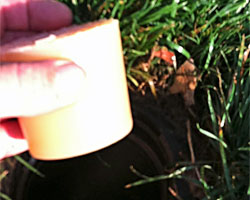
The pellet is then put inside the sprinkler head. |
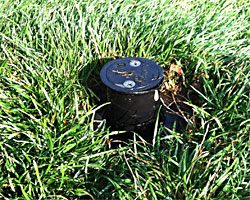
The rotor is put back in place.
|
The sprinkler will be in the raised position until the pellet dissolves over time. No harm is done to the sprinkler and the areas bounce back much quicker.".
Visit Frank's blog at fhfcgreendepartment.blogspot.com
|
 |
What's Ailing Our Greens?
John Garcia, The Patterson Club, Fairfield, CT:
 This time it's not drought, insects, or fungal diseases. It's also not nematodes, bacterial wilt, or mechanical damage. In fact the greens are quite healthy... for now. Unfortunately, they continue to be damaged on a daily basis by unrepaired and/or improperly repaired ball marks. When a ball strikes a green, it typically leaves a deep depression, and severes the roots below. If unrepaired, or improperly repaired, the grass around the mark dies, leaving behind a pock-marked, damaged surface, which is an avenue for other pests, and most importantly a perfect void for poa annua to germinate, and begin taking over our putting surfaces. This time it's not drought, insects, or fungal diseases. It's also not nematodes, bacterial wilt, or mechanical damage. In fact the greens are quite healthy... for now. Unfortunately, they continue to be damaged on a daily basis by unrepaired and/or improperly repaired ball marks. When a ball strikes a green, it typically leaves a deep depression, and severes the roots below. If unrepaired, or improperly repaired, the grass around the mark dies, leaving behind a pock-marked, damaged surface, which is an avenue for other pests, and most importantly a perfect void for poa annua to germinate, and begin taking over our putting surfaces.
The picture below was taken this past Thursday on our 14th green. We purchased 200 white marking flags to mark the damaged spots. We ran out, and had to utilize othe blue and yellow flags from inventory. We flagged 468 marks on the green!
 Although the grounds crew repairs all unrepaired ballmarks each morning, it is often too late. A mark fixed properly within the first hour of it's creation heals up to 10 times faster than one fixed outside of the one hour window. Make no mistake, it is the golfers responsibility and duty to fix their ball marks, to ensure the course be left in the best condition possible for their fellow members, as well as for their own future rounds. The USGA feels so strongly about this issue that it is addressed in Section 1 of the "Rules of Golf".
Although the grounds crew repairs all unrepaired ballmarks each morning, it is often too late. A mark fixed properly within the first hour of it's creation heals up to 10 times faster than one fixed outside of the one hour window. Make no mistake, it is the golfers responsibility and duty to fix their ball marks, to ensure the course be left in the best condition possible for their fellow members, as well as for their own future rounds. The USGA feels so strongly about this issue that it is addressed in Section 1 of the "Rules of Golf".
 Please view the following video depicting the incorrect and the correct way to make these repairs, and feel free to ask a member of the grounds or golf staff if you would like a personal demonstration. Also be sure to point out and assist your fellow members in their responsibility, and the proper technique. Thank you for your help on this very important issue! Please view the following video depicting the incorrect and the correct way to make these repairs, and feel free to ask a member of the grounds or golf staff if you would like a personal demonstration. Also be sure to point out and assist your fellow members in their responsibility, and the proper technique. Thank you for your help on this very important issue!
Visit John's blog at pattersonturfman.blogspot.com.
|
 |
Anatomy of a Bunker Problem
Trey Anderson, Hickory Ridge Golf Course, Carbondale, IL:
 "We have talked about bunkers at Hickory Ridge for quite some time. Boards have changed, my boss has changed (several times) and the plan for action has changed. The one thing that has not changed is the drainage and the quality of the sand in most of the bunkers. "We have talked about bunkers at Hickory Ridge for quite some time. Boards have changed, my boss has changed (several times) and the plan for action has changed. The one thing that has not changed is the drainage and the quality of the sand in most of the bunkers.
The economy of golf has also changed. Gone are the days of hundreds of new courses opening every year. At that time, the money or budget never seemed to be that much of a issue That building boom brought both good and bad with it. As far as bunkers go, it brought synthetic bunker liners, machines that are made to filter rocks out of existing sand (not soil), sprayed-on coatings to keep the subsurface and the sand separate, engineered bunker sand which is less prone to wash and many other new ideas and products which were introduced during the boom.
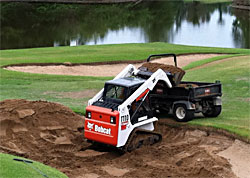
Existing sand is excavated on hole #8. |
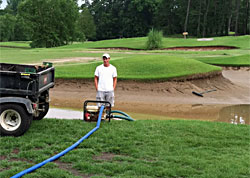
Seems like a weekly ritual this year.
|
Fast forward 15 years and the word is SUSTAINABILITY. This has many meanings to different people but as stewards of the environment, superintendents think about sustainability plenty (for good reason). My thought process has always been two fold, #1) How can we get this done and #2) What products and process will work best for our golf course (within budget and with a reasonable life span).
Over the last few years I have picked the brains of other superintendents, architects, agronomists, builders and product vendors. We are always looking for the "right way" for us. During this time period bunker projects and maintenance have elevated in price. It is another area of the golf course which has trended towards being well maintained, playable, and consistent. Now keep in mind, bunkers were no more than shelter for sheep from the gales coming in off the North Sea at St.Andrews back in golfs beginning. Those burrows have come a long way.
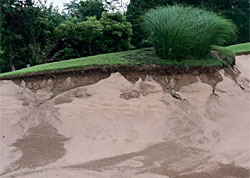
A rebuilt high flashed bunker after 3.7" of rain. We can live with this. |
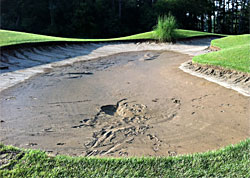
Silt that is left on the surface after a heavy rain.
|
Our problem is this: heavy rains wash sand away from the faces of the bunker cavity. The soil that is now uncovered washes a little and is left mixed in with the sand after each heavy rain event. The silt or soil slowly makes it's way down to the gravel trench which envelopes the 4" drain tile that runs down the middle (low spot) of the bunker and out to near by ditches or swales. The silt bridges with sand and rock to form a barrier to water entering the tile. Sometimes the tile itself is clogged with silt. The outcome is bunkers stay full of thousands of gallons of water until they are pumped out or drain very slowly.
Past maintenance crews have sought a stop gap fix by installing surface drains that tap into the existing drains. The problem is that if water goes in, what else goes in...sand, now you have lost a lot of sand and quite possibly have clogged drains which might have to be completely dug up.
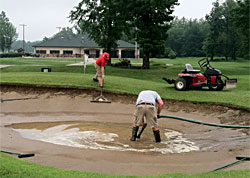
Plenty of work goes into bunkers after heavy rain. |
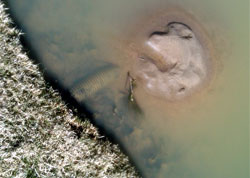
Sand from a surface drain that has washed into a nearby pond.
|
The best and only way to fix the problem is rebuild bunkers by excavating the existing sand and drain tile, installing new and possibly augmented drain tile and then refilling the bunkers with new fresh sand.
After many experiments on site, adding a perimeter drain which follows the edge of the bunker and tying it into the existing drain seems to make the washes from heavy storms acceptable. Liners and engineered sand would help even more but budget and cost of the project has eliminated those possibilities.
What is left: plenty of work. The main obstacle has been excavating the existing sand. We started by hand but with roughly 32 tons of sand coming out of one average size bunker, another method had to be found. We used several machines to help us but the one that seems to work well for us is the Bobcat T110. It is the smallest tracked skid steer I could find. The board will consider the purchase of this machine at the August meeting. Although a big trailer for transporting the sand from the sand bin at the maintenance department to the bunkers is needed, this T110 will give us a great start. Look for work on exisisting bunkers this fall and for the next few years.
After all the years of investigation and no action, I feel we have come up with a process that will work well for our members and patrons while still using only what we need to complete this project.
Visit Trey's blog at hrgcturf.blogspot.com
|
 |
Not Just Any Old Tire
Brian Boyer, Cinnabar Hills Golf Club, San Jose, CA:
 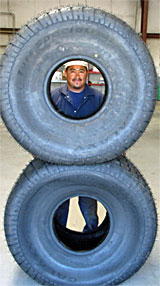 "We just got our new tires for our tractor and I thought it would provide a good photo opportunity. That is our Assistant Mechanic in the donut hole. I don't know if he did it because I told him to, but our Head Mechanic turned down the photo shoot. "We just got our new tires for our tractor and I thought it would provide a good photo opportunity. That is our Assistant Mechanic in the donut hole. I don't know if he did it because I told him to, but our Head Mechanic turned down the photo shoot.
These tires are called Galaxy tires and are considered 'flotation' tires. Very little turf damage happens with these kind of tires and for the price of $1,300 a piece, they better not cause any damage. Each tire will inflate to almost 4 ft in diameter and two feet wide.
At that price, we should turn our old ones in to make crumb rubber!
Visit Brian's blog at cinnabarhills.blogspot.com
|
 |
Special offer from TurfNet!
Want a professionally-designed custom theme for your blog?
Often it's the "little extra" that separates the ordinary from the extraordinary. Whether you have an existing blog or would like to start one but don't have a clue about image editing or graphic design, we can help. If you'd like to put a little polish on your blog, we can work up a custom theme (graphics, colors, sidebar block styles, background, etc) for you!
All we need is a good head-shot photo of yourself (if desired), several good scenic shots of your course and a club/course logo (again, if desired). Then give us an idea of a color scheme (club colors, light/dark, etc.) Contact Peter McCormick if interested.
Oh yeah, the cost: Nada. Squatola. Zero. Zip. Free. But just for TurfNet members - with our thanks for supporting what we do.
Feel guilty about it?  Just refer a new member and we'll be very happy! Just refer a new member and we'll be very happy!
Last week we revamped a website header for Tom Margetts of Innovative Agronomics, New Hamburg, Ontario.

The offer is still open, so send us some course photos (at least 1000 pixels wide), a headshot or two of yourself and a club logo... and we'll take it from there! Yet another advantage of being a TurfNet member!
|
 |
|
About our Blog Aggregator: Many superintendents are now hosting private blogs to better communicate with their golfers and/or members. Beyond local weather and course conditions, there is a great deal of information about projects, methodologies and techniques that would be of value to other superintendents — hence our Turf Blog Aggregator. As every blogger struggles occasionally with content, we also include posts intended to educate golfers about turf maintenance for others to use as a template for their own blogs.
TurfNet members: Want to share something from your blog? Send us the link.
Turf Blog Aggregator(TM) is a trademark of Turnstile Media Group.
|
|